Boosting your website's conversion rate isn’t just about driving traffic; it’s about making sure that visitors take action when they land on your site. Whether you want them to sign up, buy a product, or request a quote, optimising your conversion rate means turning visitors into engaged customers. Here’s how to do it.
- Boost Your Conversions: A Comprehensive Guide to Website Optimisation
- 1. Optimise for Speed and Performance
- 2. Streamline Your Navigation
- 3. Craft Compelling Calls-to-Action (CTAs)
- 4. Leverage Social Proof
- 5. Personalise the User Experience
- 6. Use High-Quality Visuals and Multimedia
- 7. Create an Easy Checkout Process
- 8. Optimise for Mobile Users
- 9. Utilise Exit-Intent Pop-Ups
- 10. Conduct Regular A/B Testing
- The Bottom Line
Boost Your Conversions: A Comprehensive Guide to Website Optimisation
Learn how to maximise your website's conversion rate with proven strategies. Discover tips on user experience, A/B testing, and conversion rate optimisation to drive more sales and leads.
1. Optimise for Speed and Performance
A fast-loading website is essential for conversions. Studies show that if a page takes longer than three seconds to load, most users abandon it. Speed not only affects user experience but also your SEO ranking, which can impact how easily users find you in the first place.
Quick Tips:
- Compress images to reduce load times.
- Use a Content Delivery Network (CDN) to improve loading speeds for users across different locations.
- Minimise JavaScript and CSS files to make your site lighter.
Pro Tip:
Run your website through Google PageSpeed Insights or GTMetrix to get personalised speed optimisation recommendations.
2. Streamline Your Navigation
Website visitors should find it easy to navigate your pages. A confusing layout or complex menu structure can frustrate users, leading them to abandon your site. Simplifying your navigation can help guide users directly to the information or product they’re looking for.
Navigation Best Practices:
- Keep menus minimal and limit options to essential pages.
- Use clear labels that match users’ search intent.
- Place your call-to-action (CTA) buttons prominently throughout the site.
Pro Tip:
Analyse user behaviour with tools like Google Analytics to see which pages users visit most frequently and which they tend to ignore. Use this data to refine your navigation structure.
3. Craft Compelling Calls-to-Action (CTAs)
Your CTAs play a huge role in conversions. An effective CTA is clear, action-orientated, and easy to find. It should tell users exactly what they can expect by clicking on it, whether it's downloading an e-book, signing up for a webinar, or buying a product.
CTA Tips:
- Use action words like “Get Started,” “Download Now,” or “Claim Your Offer.”
- Place CTAs above the fold and in high-visibility areas.
- Experiment with colours, shapes, and sizes to see what captures attention.
Pro Tip:
A/B test your CTAs to see which wording, placement, or colour generates the highest click-through rate. Often, small tweaks can yield significant results.
4. Leverage Social Proof
Social proof—like customer testimonials, reviews, and case studies—builds trust and reassures potential customers of your credibility. It’s one of the most powerful tools for increasing conversion rates because it validates your brand through the voices of satisfied customers.
Ways to Incorporate Social Proof:
- Display customer reviews and testimonials on your homepage or product pages.
- Show the number of users, downloads, or subscribers as trust indicators.
- Highlight any awards, media mentions, or recognitions your business has received.
Pro Tip:
Use images of real customers or their names and locations to make testimonials feel more authentic. Seeing real people’s experiences can increase trust and engagement.
5. Personalise the User Experience
Personalisation helps visitors feel valued and can significantly boost conversions. This can be as simple as offering product recommendations based on browsing behaviour or as sophisticated as dynamic content that adapts to user preferences.
Personalisation Techniques:
- Greet returning users by name or recognise their previous interactions.
- Use AI-powered product recommendations based on user behaviour.
- Send targeted email offers based on browsing or purchase history.
Pro Tip:
Use tools like HubSpot or Optimizely for easy personalisation. Personal touches can transform a generic experience into a memorable one that resonates with users.
6. Use High-Quality Visuals and Multimedia
Visual content is processed faster than text, making it an essential element in guiding user decisions. High-quality images, videos, or interactive elements can demonstrate your products more effectively and keep visitors engaged longer, boosting conversion rates.
Best Practices for Visual Content:
- Use high-resolution images and videos to showcase products from multiple angles.
- Add short explainer videos on landing pages to convey complex ideas quickly.
- Use infographics or icons to break down information in visually appealing ways.
Pro Tip:
User-generated content, like customer photos or testimonials, can also serve as high-quality visuals. Incorporating these can create a sense of authenticity that professional images sometimes lack.
7. Create an Easy Checkout Process
For e-commerce sites, a complicated checkout process can be a major conversion killer. Make it as easy as possible for users to complete their purchases by reducing steps and offering guest checkout options.
Checkout Optimisation Tips:
- Minimise form fields to only collect essential information.
- Offer multiple payment options, like credit card, PayPal, and mobile payments.
- Use progress indicators to show users how close they are to completing their order.
Pro Tip:
Implement cart abandonment emails to remind customers to finish their purchase. Many abandoned carts are simply due to distractions, so a reminder can bring back a significant portion of potential sales.
8. Optimise for Mobile Users
With a large percentage of traffic coming from mobile devices, it’s critical to ensure that your site looks and functions perfectly on smartphones and tablets. Mobile-friendly design is not only essential for SEO but also for providing a smooth user experience that encourages conversions.
Mobile Optimisation Tips:
- Use responsive design to ensure your site adapts to different screen sizes.
- Keep forms short and avoid pop-ups that can interfere with mobile browsing.
- Make sure CTA buttons are easy to tap without accidentally hitting other elements.
Pro Tip:
Use Google’s Mobile-Friendly Test tool to identify areas where your mobile experience could be improved. With mobile traffic continually on the rise, a mobile-optimized site is a must.
9. Utilise Exit-Intent Pop-Ups
Exit-intent pop-ups detect when a user is about to leave your website and display a last-minute offer, lead magnet, or discount to encourage them to stay. When used wisely, exit intent pop-ups can help capture users who would otherwise leave without converting.
Exit-Intent Strategies:
- Offer a discount code to first-time visitors who are about to leave.
- Use a lead magnet, like a free e-book or guide, to capture email addresses.
- Ask for feedback in exchange for a small incentive or coupon.
Pro Tip:
Experiment with the timing and messaging of exit pop-ups. Some users find pop-ups intrusive, so it’s important to use them sparingly and make sure they provide real value.
10. Conduct Regular A/B Testing
Optimisation is a continuous process, and A/B testing allows you to make data-driven decisions about what works best for your audience. By testing different versions of headlines, CTAs, layouts, and other elements, you can refine your site over time for maximum conversions.
Elements to the A/B Test:
- Headlines and subheadings
- CTA button colours, shapes, and wording
- Product descriptions or images
- Page layouts and navigation menus
Pro Tip:
Stick to testing one variable at a time to get clear results. This way, you know exactly which change impacted conversions, helping you make informed decisions.
The Bottom Line
Maximising your website’s conversion rate requires a mix of data analysis, design tweaks, and user-focused strategies. By streamlining navigation, using persuasive CTAs, incorporating social proof, and focusing on the mobile experience, you can create a website that doesn’t just attract visitors but effectively converts them into loyal customers. Remember, conversion rate optimisation is a continuous process, so keep testing and refining to stay ahead.







